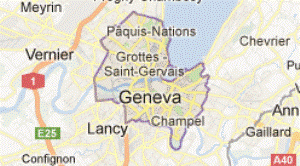ISRAEL-PALESTINE
Snow Job About Israel-Palestine - An Analysis
December 24, 2013 · 2 Comments

Above: Image from NYT eXaminer stock photos.
By Lawrence Davidson:
In our house we get the New York Times (NYT) because the Philadelphia Inquirer’s (that is our city paper) coverage of international affairs is very limited. Sometimes I wonder why we bother. One can find a more thorough and certainly more balanced coverage on the web. However, we still enjoy the tradition of perusing a newspaper at the breakfast table.
It is important to keep in mind that a newspaper, or really any media source, really, is a reflection of the political and cultural sensibilities of its owners and managers. So you can politically and culturally peg those who run a media outlet such as a newspaper by what makes up its content as well as what is left out.
For instance, take the front page of the NYT for Saturday, 14 December 2013. There, above the fold, we find a large picture of what looks like a resort in the middle of a snowstorm. The description under the picture orients us: “Under a Snowy Sky in Jerusalem, Laps in a Pool. A snowstorm around Jerusalem disrupted travel and electricity on Friday but did not deter a swimmer at the David Citadel Hotel.” Beyond these few words there is no story. There is just the picture of what is an unusual climatic occurrence. Yet the photo also presents an image of Israel as a well-developed place. Some might see the photo as proof of their conviction that the Israelis really have made “the desert bloom” - with swimming pools.
Part II - What Is Left Out?
One thing you will not learn from the NYT is that Israeli development is always balanced by Palestinian de-development. This is the inevitable result of the fact that Israel is a nation built on property acquired through a long and ongoing process of ethnic cleansing. This consistent off-setting of development with de-development is reflected in present-day conditions in the Gaza Strip.
On the same day that the NYT put its poolside “Snowy Sky in Jerusalem” picture on its front page, a spokesperson for the United Nations Relief and Works Agency (UNRWA) stated “Large swathes of Gaza are a disaster area with water as far as the eye could see. ... Any normal community would struggle to recover from this disaster. But a community that been subjected to one of the longest blockades in human history, whose public health system has been destroyed and where the risk of disease was already rife, must be freed from these man-made constraints to deal with the impact of a natural calamity such as this.”
The flooding in the Gaza Strip is in part a consequence of the same snowy weather depicted in the NYT’s Jerusalem photo. However, it is also the consequence of Israel’s systematic destruction of the infrastructure of the Gaza. That process of de-development has been going on for a long time. Thus, no one should be impressed because the Israelis, responding belatedly and half-heartedly, recently permitted into Gaza two weeks worth of fuel and some pumps to help with the flooding. These were not timely gifts from a concerned neighbor. Most of these supplies were paid for by Qatar. It is to be noted that Gaza’s only power plant went dead months ago thanks to Israel’s refusal (here assisted by the blockade of Gaza imposed by the truly wretched military dictatorship in Egypt) to allow the importation of adequate fuel supplies and replacement parts for its infrastructural equipment. Gazans have been subsisting on an average of three hours of electricity per day.
On 15 December 2013 the NYT did print a piece entitled “Gaza, Vexed by Floods, Gets Fuel and Power.” However, reading this piece (which did not include the UNRWA statement) you get the impression that the Israelis have nothing to do with Gaza’s problems. The article makes it seen that the fault lies with the West Bank Palestine Authority (PA). It claims, that the PA “can always ship oil to Gaza through Israel.” This is a highly misleading claim, for the Israelis regulate the importation of fuel to a trickle of the population’s real need. However, the article goes on to claim that the PA taxes the fuel and this contributes to its scarcity in Gaza. Laying the blame on the Palestine Authority, as awful as the organization otherwise might be, is a terrible distortion of the truth.
Part III - Rationalizations
Of course, both the Israelis and those who run the NYT have their reasons for acting as they do.
The Israeli rationale goes something like this: The Palestinians hate us and want to destroy our state. The Hamas government in Gaza even fires missiles into southern Israeli cities. We keep all the people of Gaza locked up in order to protect ourselves from their enmity.
Yes, some of this is accurate. But why deal with the situation by locking 1.6 million people up in a ghetto, reducing them to poverty, and systematically destroying their infrastructure? (A particularly ironic strategy by a state, Israel, that claims to represent a people who were themselves oppressed in ghettos.) Is it revenge for those missile attacks which are themselves revenge for Israeli aggression? Despite the fact that Israeli hatred and fear of the Palestinians quite equals that of their adversaries, I don’t think the revenge hypothesis fully explains Israeli behavior.
It is probable that the Israelis would have no need to implement their ghetto strategy if they were ready to reach a just and fair solution with all of the Palestinians (the PA represents only a shrinking minority). However, they are not willing to do this, so the ghetto strategy follows naturally. As long as Israel persists in stealing Palestinian land in a process of relentless expansion, they must convince themselves of the irreconcilable nature of the conflict and persecute not only those who would resist, but the entire population of Palestinians.
How about the NYT? Why is it that its staff refuse to accurately contextualize the paper’s coverage of Israel-Palestine? Part of the answer is to be found in the imperatives of running a newspaper business (that is, selling advertising) in the ethnic climate of New York City. However, to this must be added the fact that most of the NYT’s editors and reporters working on Israeli and Palestinian issues are just the latest generation in a long line of supporters of the Zionist movement. They probably prefer so-called moderate Zionists rather than hard-core Likud-style ones such as Benjamin Netanyahu, but in practice this does not matter. They are sufficiently dedicated to Israel as a “Jewish State” to support it regardless of its sins. Thus, de facto, the NYT’s self-censors when it comes to Israel’s behavior.
Part IV - Alternative Reads
Of course, readers are not limited to the NYT or any of the mainstream media. The World Wide Web has liberated us from these sources if only we know about the alternatives and take the time to go to them. I encourage readers to consult the links at the side of the home page of my blog, www.tothepointanalses.com, for some of these important sources. In addition I have listed below other examples of sites that give a different take on U.S. government behavior both at home and abroad:
-- Electronic Intifada at http://electronicintifada.net/
-- Middle East Research and Information Project at http://www.merip.org/
-- Washington Report on Middle East Affairs at http://www.wrmea.org/
-- Mondoweiss at http://mondoweiss.net/
-- Ma’an News Agency at http://www.maannews.net/ENG/
-- 972 Magazine at http://972mag.com/
There are many others as well. The important point is not to remain passive and, out of inertia, simply rely the mainstream media at hand. To do so is to lock yourself away in a small and easily manipulated world that, almost inevitably, will have you justifying unnecessary warlike actions against peoples whose enemy status is based more on propaganda than truth.
The real world is much larger. It deserves a bit of effort to get an accurate sense of what is happening to it, and to you.
By admin
Readers Comments (2)
Sorry, comments are closed on this post.










Jews, Muslims, Hindus, Christians all do dangerous violations of civil rights. THAT’S where the attacks originate.
Don’t feel bad. Secular humanists get attacked, too.
Gaza-Israel war?
These wars are not about Israel.
The war is not about land, borders, settlements, ports, fishing, etc.,
The continuing source of Hamas intransigence despite losing was expressed by a Palestinian leader during the Lebanon war.
George Habash, a Greek Orthodox Christian, was known as “the godfather” of Middle East terrorism.
Habash’s group, the Popular Front for the Liberation of Palestine (PFLP), pioneered the hijacking of airplanes as a Middle East terror tactic and triggered the Jordan’s Black September civil war. He masterminded the murder of Israeli atheletes at the Olympic Village in Germany. He was never troubled by the thought of the innocent victims of terrorism, the seven Jews burned in the synagogue in Hamburg, forty-seven passengers (including children) who died in the Swiss plane which exploded in flight and crashed into the forest Doettingen, civilians torn apart by dynamite in the offices of El Al in Europe.
He said, “The end always justifies the means. To kill a Jew away from the battlefield has more effect than killing a hundred Jews in battle.”
When told that many of the Palestinians were disproportionately being killed in the Lebanon war, he responded that he didn’t care, because no matter how few, “We are killing Jews!”
The Palestinian leadership—both Hamas and Fatah as well as its people—are mesmerized by what Thomas Mann’s friend (who lived in Nazi Germany) called the “sorcery of violence.”
Those in Nazi Germany lost their souls.
It is happening in Gaza and the West Bank.
Anti-Semites all end up forever in the deepest pits of the fiery fires of hell.